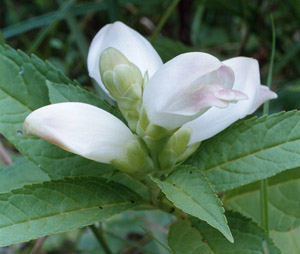
Marsh Speedwell, Snapdragon family (Scrophulariaceae), Native


|

Speedwells typically spread quickly, both by underground runners and by seed. The flowers can also fertilize themselves, so they produce seeds even when they have not been pollinated in the normal course of events. Their rapid spread may have earned them the name speedwell.
Speedwells have historically been put to numerous medicinal uses, both interally and externally. Not
surprisingly, these uses are another likely source of the name speedwell.
Turtlehead, Snapdragon or Figwort family (Scrophulariaceae), Native

|
Nestled here and there along the banks of the stream that feeds the Reservoir, turtleheads (Chelone glabra) make their appearance around the first week of September. The plants are perennials, so they can usually be found in the same spots year after year. The large one-to-two-inch white blossoms are sometimes tinged with pink.
The plant gets its name from the shape of the flowers. They look somewhat like the head of a turtle. The top of the flower resembles the shape of a turtle's shell.
Turtleheads are pollinated mainly by large bees, which can force their way into the flowers. As a bee pokes around inside a flower, in search of nectar, the flower moves in such a way that it can look like it is chewing something--an amusing sight.
Turtleheads are related to butter-and-eggs and to garden snapdragons. Pink or purple species grow in
the southern states.
Closed Gentian, Gentian family (Gentianaceae), Native
|

The markings around the small opening at the tops of the flowers provide cues for bees. The newer flowers in a cluster, which are well supplied with nectar, are white at the very tips of the closed petals, marking the entrance for the bees. Older blossoms turn blue-purple around the opening, and bees no longer visit them.
A similar species, Andrew's bottle gentian
(Gentiana andrewsii), is also found in New England but is rare in our area. The two species
are almost indistinguishable without close inspection. One way to tell the two apart is to examine
the flowers by spreading the tips open. In both species the petals are joined by a
fringed membrane. In Gentiana clausa the fringe comes up to the tips of the petals, whereas
in Gentiana andrewsii the fringe is longer than
the petals. Only Gentiana clausa grows at the Reservoir.
Nodding Ladies'-tresses, Orchid family (Orchidaceae), Native

|
Early autumn brings out low spikes of small white orchids, known as common or nodding ladies'-tresses (Spiranthes cernua). Growing about 18 inches high in sunny, sandy areas near water, the plants bear numerous blossoms on a twisting stem. The name "ladies'-tresses" is due to the way the flowers seem to be woven into the stem, as if in a braid or "tress". The flowers are "nodding" because they point slightly downward, an arrangement that keeps rain out, preventing the nectar from becoming diluted. The flowers have a sweet fragrance that attracts bees.
As in many other plants that flower in spikes, the flowers open progressively from the bottom of the spike up. This sequence puts the newer flowers, which produce pollen, at the top of the spike and the older, more mature flowers, which are ready to receive pollen, at the bottom. This set-up suits bees' habit of climbing up a spike of flowers and then starting again at the bottom of the next spike. In the process, the bees transfer pollen from the younger flowers at the top of one plant to the older, receptive flowers at the bottom of the next plant.
The nodding ladies'-tresses have evolved even more specific ways of ensuring that bees transfer pollen. Bees gather nectar with their tongues. When a bee visits a new flower, its tongue splits open a disk inside the flower, releasing a sticky glue that helps clumps of pollen stick to the bee's tongue. Then, when the bee goes to the bottom of the next spike, it visits older flowers in which the split has widened enough to expose the flower's pollen-receiving parts, which pick up the pollen already stuck to the bee's tongue.
Like other orchids, nodding ladies'-tresses may need certain soil fungi to grow.
| show TOC frame | Table of Contents | 
|
| Home / Contact | ||
Copyright © Anne A. Reid, 1999-2002. Photographs copyright © Garry K. Kessler, 1999-2002. | ||